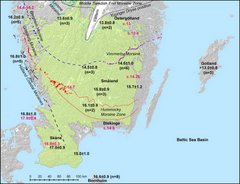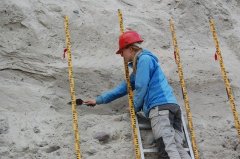Research projects
On this page I present some of the projects I am or have been involved in. These projects include a reconstruction of the development of the Baltic Sea basin during the last ice age and a new deglaciation chronology for south Sweden based on cosmogenic surface exposure dating. I will also write about an expedition to Siberia which I participated in and about why we believe that Dalarna in central Sweden was ice-free in the middle of the last ice age.
Sediment cores reveal the ice age history of the Baltic Sea
Investigations of sediment cores from Kriegers Flak in the southern Baltic Sea reveal the deveolpment of the region
during the last 55 thousand years. It is a dynamic history with repeated glaciations but also periods with brackish
conditions and periods when parts of the current Baltic Sea were dry land.
Read more.
 New deglaciation chronology for south Sweden
New deglaciation chronology for south Sweden
In this study we present new age constraints for the deglaciation of southern Sweden based on cosmogenic surface exposure dating.
We also provide a map with suggested deglaciation ages based on the new data and selected existing dates from the region.
Read more.
 Research expedition to Taymyr
Research expedition to Taymyr
During the summer of 2012 I participated in a seven week long expedition to Taymyr. The aim of the expedition was to
date the glaciations in the region. We therefore travelled in zodiacs along the Luktakh, Upper Taymyr and Logata rivers,
a total distance of almost 350 km.
Read more.
 Ice free conditions in central Sweden in the middle of the last ice age
Ice free conditions in central Sweden in the middle of the last ice age
The Scandinavian ice sheet at its largest extent covered large parts of northern Europe. However, during parts of the last ice age the ice sheet was
significantly reduced. In this study we have studied sediments outside of Idre, west-central Sweden, and found
that the area must have been ice free at som point between 50 and 40 thousand years ago, in the middle of the last ice age.
Read more.

